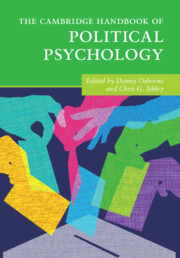Book contents
- The Cambridge Handbook of Political Psychology
- The Cambridge Handbook of Political Psychology
- Copyright page
- Dedication
- Contents
- Figures
- Tables
- Contributors
- Part I Foundations of Political Psychology
- 1 Political Psychology
- 2 The Evolutionary Basis of Political Ideology
- 3 Genetic Contributions to Political Phenomena
- 4 The Psychology and Neuroscience of Partisanship
- 5 The Personality Basis of Political Preferences
- 6 The Structure, Prevalence, and Nature of Mass Belief Systems
- 7 The Psychology of Public Opinion
- 8 Rational Choice and Information Processing
- 9 Emotions and Politics
- 10 The Developmental Science of Politics
- Part II The Politics of Intergroup Attitudes
- Part III Contemporary Challenges to Democracy
- Part IV Diversifying Perspectives in Political Psychology
- Index
- References
2 - The Evolutionary Basis of Political Ideology
from Part I - Foundations of Political Psychology
Published online by Cambridge University Press: 17 February 2022
- The Cambridge Handbook of Political Psychology
- The Cambridge Handbook of Political Psychology
- Copyright page
- Dedication
- Contents
- Figures
- Tables
- Contributors
- Part I Foundations of Political Psychology
- 1 Political Psychology
- 2 The Evolutionary Basis of Political Ideology
- 3 Genetic Contributions to Political Phenomena
- 4 The Psychology and Neuroscience of Partisanship
- 5 The Personality Basis of Political Preferences
- 6 The Structure, Prevalence, and Nature of Mass Belief Systems
- 7 The Psychology of Public Opinion
- 8 Rational Choice and Information Processing
- 9 Emotions and Politics
- 10 The Developmental Science of Politics
- Part II The Politics of Intergroup Attitudes
- Part III Contemporary Challenges to Democracy
- Part IV Diversifying Perspectives in Political Psychology
- Index
- References
Summary
This chapter aims to synthesise recent research studying political ideology from an evolutionary perspective. We begin by outlining how evolutionary theory can be applied to human psychology. We then review recent lines of evolutionary research linking variation in political ideology to physical formidability, the behavioural immune system, threat sensitivity, and evolved moral foundations. We synthesise this research with a novel framework of political differences inspired by recent independent, convergent evidence for two key shifts in the evolution of human group living. This evolutionary framework explains economic and social conservatism as emerging from two fundamental human social drives: cooperation and group conformity. We conclude with some remaining questions and future directions for evolutionary approaches to political ideology.
Keywords
- Type
- Chapter
- Information
- The Cambridge Handbook of Political Psychology , pp. 22 - 36Publisher: Cambridge University PressPrint publication year: 2022
References
- 3
- Cited by



